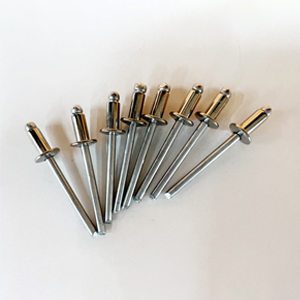The earlier rivets were small nails made of wood or bone, and the very early metal deformers were probably the ancestors of the rivets we know today. There is no doubt that they are the oldest known method of joining metals, dating back to malleable metals For example, in the Bronze Age, the Egyptians riveted together 6 wooden sectors on the outer line of the slotted wheel, and the Greeks succeeded in casting large statues in bronze, then riveting all the parts together with rivets.
In 1916, when HVWhite of the British aircraft manufacturing company began to patent blind rivets that could be riveted on one side, it was hardly expected that such rivets would be used so widely today. From aerospace to office machines, electronics, playgrounds It can be said that this blind rivet has become an effective and stable mechanical connection method.
Most blind rivets were invented for making or repairing harnesses. It's not clear when hollow rivets were invented, but harnesses were invented in the 9th or 10th century AD. Riveted harnesses, like those with nails Horseshoes, freed slaves from heavy labor. Rivets also led to many important inventions, such as iron pliers for copper and iron workers and shears for shearing wool.
The working principle of blind rivets is realized by pulling the core head with a force from the inside to the outside. If you want to make better use of blind rivets, you must first understand the working principle in detail.
Open oval head blind rivets have a wide range of applications, countersunk head blind rivets are suitable for riveting occasions where smooth surfaces are required, and closed blind rivets are suitable for riveting occasions that require high load and certain sealing performance.
The riveting of blind rivets is to use a metal cylindrical or metal tube (rivet) with a diameter slightly smaller than the perforation to pass through the workpiece to be riveted, knock or pressurize the 2 end faces of the rivet, deform and thicken the metal column (tube), and form a rivet at the two ends. Head (cap), so that the workpiece can not be released from the rivet. Under the action of the external force to separate the workpiece, the nail rod and the nail cap are subjected to shearing force to prevent the workpiece from separating.

Related Industry Knowledge
- Types and uses of rivets
- Use of rivet gun
- Application and characteristics of lantern rivets
- Dealing with surface problems and common phenomena of blind rivets
- Rivet nuts and their installation and precautions
- Introduction of seahorse rivets
- The difference between ring groove rivets and groove rivets
- The use and precautions of ring groove rivets
- Uses and advantages of large brim blind rivets
- Characteristics of brushed rivets
- How to choose blind rivets, and what aspects must be paid attention to?
- The whole process of using and installing ring groove rivets
- What are the solutions when the riveting gun fails?
- Common problems when installing ring groove rivets
- How to use a rivet gun
- What should you pay attention to when designing brushed rivet structures?
- Precautions for using ring groove rivets
- Characteristics and uses of lantern rivets



